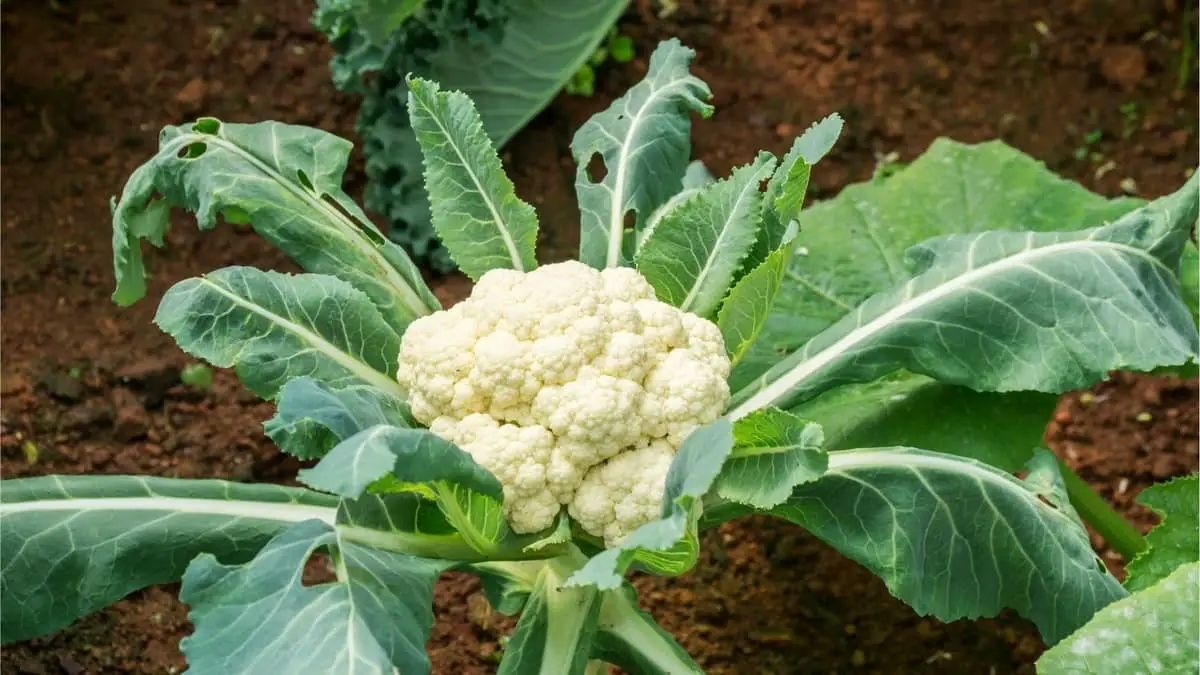Last Updated on January 9, 2022 by Griselda M.
Correctly spacing out your vegetables is crucial as it allows them to develop their full potential, so how far apart to plant cauliflower? Cauliflower grows big heads and naturally needs a lot of nutrients from the soil.
When planted too crowded, it won’t form a nice head. In some cases, it won’t even form a head! Prevent the damage before it happens. Don’t end your season devastated that your cauliflower did not produce anything.
Read on to learn how to correctly space out the cauliflower.
Cauliflower – The King Of Versatility
The cruciferous vegetable gained massive popularity in recent years. Many newbie gardeners start to grow it at home as it’s a staple in vegan cuisine. It’s gratifying to have it in your garden as the whole plant is edible, including leaves and stems.
But as easy as it seems, cauliflower is a demanding vegetable. It’s temperature-sensitive, requires rich soil, consistent moisture, and plenty of sunshine.
Most importantly, cauliflower is a giant vegetable. It grows 12 to 24 inches wide and 12 to 30 inches tall. We’re aiming for a prosperous product, so correct spacing is one of the starting points.
Cauliflower Plant Spacing Importance
The main reason why a cauliflower doesn’t form a head is the overcrowding. The seeds are started inside a few weeks before the last frost. Then, after the last frost has passed, you can transfer the seeds in-ground. Unfortunately, this is where many gardeners make the biggest mistake. Here’s what overcrowding can lead to.
Development of fungus
Cauliflowers are covered with many leaves, so as the vegetable grows, they spread out. When two or more roots are closer than recommended, there’s a lack of air circulation. Trapped air becomes hot and humid, becoming the perfect breeding ground for fungus and bacteria.
Head disorders
Head disorders like browning and yellowing are a result of a lack of micronutrients in the soil. When spaced out correctly, each plant will get its needs sorted out from the soil. But when two or more roots are fighting for food, it results in a damaged and bitter vegetable.
Ricing
You’ve heard of cauliflower rice which is grated cauliflower, but this ricing is not as tasty. When the heads start forming grainy florets, it’s a result of too much humidity between the vegetables. There’s minimal air circulation, so the heads can’t develop proper smooth florets.
Lack of hydration
The lack of moisture resulting from overcrowding is more common than you thought. Cauliflower needs ample hydration to grow properly. Lack of hydration leads to buttoning. So instead of one giant head of cauliflower, you get tiny separated button florets.
How To Plant Cauliflower?
Cauliflower needs well-draining, rich and neutral soil. Before sowing, you should work in some organic matter as compost into the ground. Then, plant the seeds directly in-ground or start them inside.
The garden bed must be exposed to full sun and water frequently. Although it’s planted in the most fluctuating seasons – spring and fall, cauliflower despises changes. Any drastic change in weather, moisture, pests results in ruined growth.
Blanch the non-self-blanching variants. As soon as the head develops around 3 to 4 inches in diameter, take the outer leaves and tie them to cover the head. This prevents andy discoloration. Approximately 12 days after this, the cauliflower is ready for harvest.
How Far Apart Do You Plant Cauliflower?
Cauliflower seeds need to be planted in rows. Each row needs 36 inches, and each plant needs 25 inches between. It seems too much when looking at the empty garden bed, so you might try to plant them closer. But once they start developing, you’ll notice the overcrowding.
If you don’t have enough space, it’s better to plant fewer roots instead of squeezing more. Space allows for proper, big heads, healthy and nutritiously rich vegetables. You’ll save time and money since you won’t have to deal with head disorders, fewer pests, and fungus.
Cauliflower Spacing In Different Varieties
All cauliflower types don’t vary as much in size.
White Corona Hybrid grows 3 to 5 inches in diameter, so it’s the tiniest cauliflower you can plant. It’s perfect if you have limited space. You can cut a few inches from the required distance.
The Cheddar Hybrid is the second smallest, ranging from 4 to 7 inches in diameter when mature.
The early White Hybrid grows up to 9 inches in diameter, so you can an inch or 2 of distance when sowing.
How Big Do Cauliflower Heads Get?
Cauliflower is an annual vegetable that produces a single harvest. Each plant grows one head that weighs 11 to 18 oz. The heads can go from 6 to 8 inches in diameter when fully grown.
Depending on the variety, you can harvest the cauliflower heads 50 to 100 days after sowing. After that, you can leave the plant in the soil in order to produce seeds, or you can discard it.
Nutritional Benefits Of Cauliflower
Cauliflower is rich in fiber, antioxidants and low in carbs. It’s frequently used as a flour, beans, and legumes substitute in keto diets. Just 100 grams provide at least a third of your daily intake of vitamin C, B6, K, and Folate.
Cauliflower can help those looking to lose excess weight as it’s low-calorie and high-volume food. In addition, it has high water content and is rich in chlorine.
However, cauliflower is not recommended to anyone. Consult your doctor if you’re suffering from indigestion or have thyroid issues. It might also interfere with blood-thinning medicine used for cardiovascular problems.
Final Say: How Far Apart To Plant Cauliflower?
Cauliflower is an excellent vegetable for intermediate gardeners as it’s very rewarding. All parts of the plant are edible and rich in nutrients. However, proper spacing is essential in order to grow a healthy vegetable.
Leave at least 24 inches between each plant and 36 inches between each row. Some smaller varieties might tolerate a couple of inches less distance. If you lack space, please plant fewer roots instead of squeezing them together.
Overcrowding leads to fungus development, browning, ricing, and lack of hydration. Some cauliflower plants might never develop a head because they’re planted too close to each other.
Mary is a passionate gardener who loves spending her days getting her hands dirty and nurturing her plants. She‘s an avid reader of gardening magazines and is always looking for new ways to make her garden thrive. When not outside tending to her plants, Mary can be found inside reading up on the latest gardening trends, comparing notes with fellow gardeners, and finding the perfect pottery planter for her next planting project.




